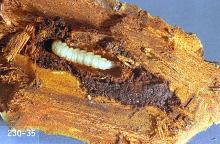Synanthedon exitiosa
Pest description and crop damage The adult male is a steel-blue, clear-winged moth with an approximately 1-inch wingspan. The female is similar in appearance but has smoky-colored wings and an orange band around her abdomen. Adult flight is usually from late June through September and eggs are laid at or on the base of the fruit tree. Larvae burrow in the crown and roots, girdle young trees, and weaken others. A single larva can girdle a newly planted fruit tree. Larval presence can best be detected by globs of gum mixed with a granular brown frass (excrement) that appear at the base of infested fruit trees. Full-grown larvae are 1.0 to 1.4 inch in length with a whitish body and a brown head.
Biology and life history The borer overwinters as a larva under the tree bark, usually below the soil surface. As temperatures rise above 50°F in the spring, the larva resumes feeding on the tissues under the bark. Larvae reach maturity from May to June and pupate in trees. Adult moths emerge beginning in June and continue to emerge through September. Mating and egg laying occurs throughout this period. The young larvae hatch after 8 to 10 days and immediately bore into the base of the tree. Larvae in the bark above the soil surface usually do not survive the winter in cold areas.
Pest monitoring Periodically scout the base of the trunk near the soil surface for excessive gummosis mixed with granular frass. Pheromone traps are available to monitor adult male moth activity.
Management-cultural control
Protect the base of the fruit tree from larval entry by placing a plastic or metal cone or barrier around it before egg laying begins. The cone should be pushed one to two inches into the soil and should fit snugly around the trunk at the top to prevent the tiny larvae from getting beneath it. Alternatively, if there are only one or a few peach trees in a home orchard, it may be quicker and cheaper to control this insect by "worming; " i.e., using a pocketknife, wire, or some pointed instrument to remove dirt around the tree and dig out the larvae.
Management-chemical control
Spray applications, and more importantly pesticide residues, on the trunk of the tree can prevent newly hatched larvae from boring beneath the tree bark and entering the woody trunk where they are protected from all insecticide sprays.
Management-chemical control: HOME USE
- azadirachtin (neem extract)-Some formulations are OMRI-listed for organic use.
- gamma-cyhalothrin-Highly toxic to bees.
- lambda-cyhalothrin-Highly toxic to bees.
- zeta-cypermethrin-Highly toxic to bees.
Management-chemical control: COMMERCIAL USE
Spring applications
Dispensers must be in the orchard before adults begin flying, typically in late June. Place dispensers in the upper half of the tree. Some formulations are OMRI-listed for organic use.
- Isomate P Pheromone at 100 to 250 dispensers/A.
Spring and summer sprays
- esfenvalerate (Asana XL) at 4.8 to 14.5 fl oz/A. REI 12 hr. PHI 14 days. Apply as directed trunk spray using thorough coverage. Extremely toxic to fish and aquatic invertebrates; avoid spray drift and runoff to surface waters.
- permethrin (Pounce 25WP) at 6.4 to 16 oz/A. REI 12 hr. PHI 14 days. Extremely toxic to fish and aquatic invertebrates; avoid spray drift and runoff to surface waters.





